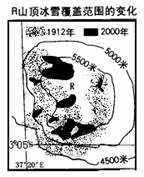问题
选择题
图是1912年和2000年世界某山地山顶冰雪覆盖范围变化图。读图回答问题。

小题1:1912年至2000年该山地冰雪覆盖范围变化,反映了
A.地壳活动加剧
B.日地距离缩短
C.黄赤交角变大
D.全球气候变暖小题2:图中反映的问题带来的影响是
A.海平面上升,海岸侵蚀加剧
B.冰川融水增多,全球水量增加
C.海洋面积增大,海岸线长度增加
D.热量消耗增多,全球温度下降
答案
小题1:D
小题1:A
本题考查全球气候变化。
小题1:图示反映山地冰雪覆盖范围缩小,主要原因是全球气候变暖,冰雪大量融化。
小题1:全球变暖导致海平面上升,海岸侵蚀加重。
